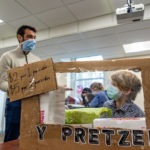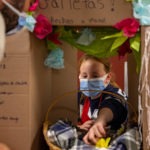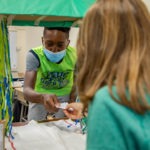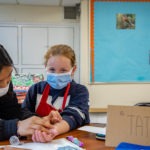¿Cuánto cuesta?


"My main goal was to help the students feel more confident and comfortable speaking the language with their peers."
Mr. Rincon
Students in Profesor Rincon’s Spanish 1A class recently created a marketplace with an array of goods and services to simulate conversational dialogue en español. Using Monopoly money, students practiced asking, ¿Cuánto cuesta? to make purchases and ask follow-up questions. Vendedores (Vendors) found themselves vying for business and sweetening deals by adding in a donut or a fresh flower to the final sale. Food items seemed to be the most popular, including fresh Dunkin Donuts, homemade galletas and homemade Rice Krispies Treats. And, a tienda de tatuaje (tattoo parlor) had a steady stream of customers, including Profesor Rincon, who opted for a tattoo of the moon, or “La Luna” in Spanish.
The learning objectives of this project were multifaceted. “My main goal was to help the students feel more confident and comfortable speaking the language with their peers,” explains Profesor Rincon. They worked on vocabulary and verbs related to shopping with the purpose of using them in a real-world situation. “I believe students are more motivated to learn when they can clearly answer the question, ‘Why are we learning this, Mr. Rincon’? On one hand, I hope they can successfully buy products when they visit a Hispanic country in the future. On the other hand, I also hope they can acquire the basic knowledge in Spanish to sell something they are passionate about.”
In Mr. Rincon’s other sections, students also sold peluches (stuffed animals), productos para el cuidado de cabello (hair care products), ropa de deporte y zapatillas (sports clothing and sneakers), and suministros de clase (school supplies).




This website uses cookies so that we can provide you with the best user experience possible. Cookie information is stored in your browser and performs functions such as recognising you when you return to our website and helping our team to understand which sections of the website you find most interesting and useful.
Read our full privacy policy for more information.
Strictly Necessary Cookie should be enabled at all times so that we can save your preferences for cookie settings.
If you disable this cookie, we will not be able to save your preferences. This means that every time you visit this website you will need to enable or disable cookies again.
This website uses Google Analytics to collect anonymous information such as the number of visitors to the site, and the most popular pages.
Keeping this cookie enabled helps us to improve our website.
Please enable Strictly Necessary Cookies first so that we can save your preferences!